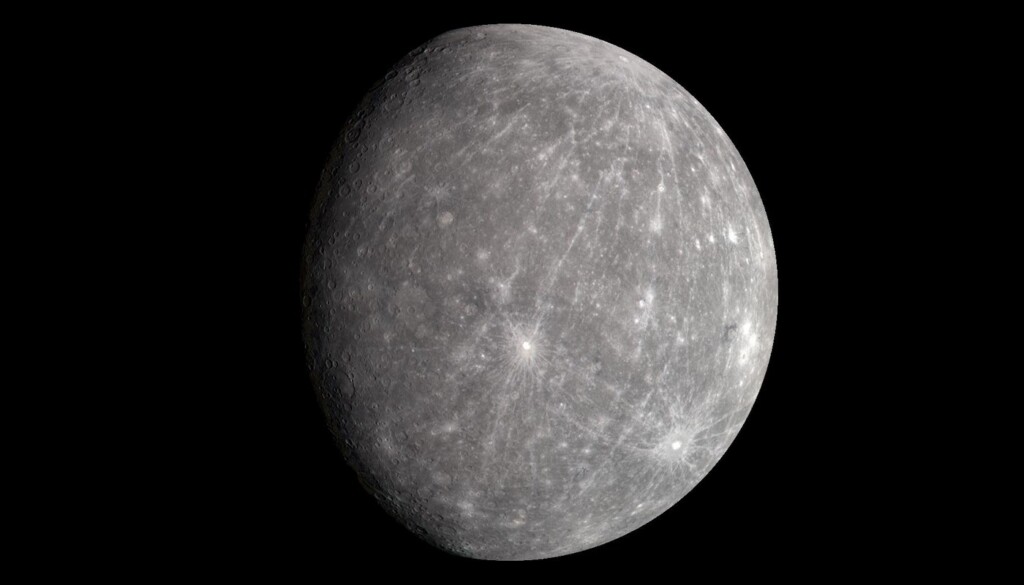 Mercury’s True Color is in the Eye of the Beholder – credit NASA / Johns Hopkins University.
Mercury’s True Color is in the Eye of the Beholder – credit NASA / Johns Hopkins University.A bi-disciplinary scientific study has revealed the likely presence of a layer of diamonds 11 miles thick at the boundary layer of Mercury’s core and mantle.
It was a remarkable finding, and came from what is the least understood planet in the solar system, despite being one of the closest to Earth.
Diamonds are forever—a girl’s best friend—but more importantly for science, they are pure carbon. Carbon is an awfully common chemical to find in the solar system, and many sources can become diamonds under the correct pressures and temperatures.
When viewed by the MESSENGER spacecraft from 2011 to 2015, Mercury appears exceptionally grey due to the high content of graphite on the planet. This mineral, responsible for our pencil tips among other things, is another form of pure carbon, and was a clue for the researchers that diamonds might be richly present beneath the surface.
“We know there’s a lot of carbon in the form of graphite on the surface of Mercury, but there are very few studies about the inside of the planet,” said Yanhao Lin, a staff scientist at the Center for High Pressure Science and Technology Advanced Research in Beijing and co-author of the study, which appeared in June in the journal Nature Communications.
In their study, the researchers placed graphite in a special pressure machine along with a smattering of elements believed to be rich in Mercury’s mantle layer, including silicon, titanium, magnesium, and aluminum.
They subjected the mixture to 70,000 times the pressure of Earth at sea level, and 2,000° Celcius (3,630 degrees Fahrenheit). These are the conditions believed to have been present at the core-mantle boundary layer while Mercury was forming 4.5 billion years ago when it coalesced from clouds of gas and dust.
Electron microscopy revealed that the mixture melted and the graphite had turned into diamond crystal.
By examining data from the MESSENGER mission about the mineral composition and depth of Mercury’s crust, mantle, and planetary core under the context of their experiment, the authors estimate the layer of diamonds should be about 11 miles thick.
MORE OUTER SPACE SURPRISES: This Asteroid is a $10,000-Quadrillion Lump of Iron and a Potential Opportunity to Study an Exposed Planetary Core
It wouldn’t be possible to mine these diamonds for the same reason it isn’t possible to mine Earth’s mantle—it’s’ hundreds of miles below the surface.
“However, some lavas at the surface of Mercury have been formed by melting of the very deep mantle. It is reasonable to consider that this process is able to bring some diamonds to the surface, by analogy with what happens on Earth,” said Bernard Charlier, head of the department of geology at the University of Liège in Belgium and a coauthor of a study.
DIAMOND STORIES: Scientists Grow Micro-Diamonds ‘from Scratch’ in 15 Minutes Thanks to Groundbreaking New Process
It’s nothing to scoff at, and though mining equipment would have to withstand surface temperatures hotter than 500 degrees Fahrenheit, humanity has already mined two asteroids using robots, and the company Trans Astra is already preparing to release a suite of asteroid mining craft.
It makes perfect sense to outsource the collection of these jewels to a planet where mining operations won’t endanger a single animal, release runoff into approximately zero rivers, dispossess not one person from their land, cause zero civil wars, and fell zero trees.
SHARE This Amazing Discovery Just A Stone’s Throw From Earth…
Source link

